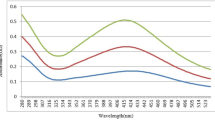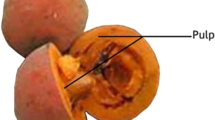Abstract
This study employed an electrical spark discharge method (ESDM) to prepare a nano-Ag colloid as an antifungal solution. The solution was diluted to two concentrations, and the fungal medium prepared in this study was coated with Aspergillus niger. The nano-Ag colloid solution was mixed with A. niger in various concentrations and dripped onto 3M Petrifilm plates. Inhibited growth observed after several days confirmed the antifungal effect of the nano-Ag colloid on A. niger. Because direct washing produced inaccurate quantitation and yielded A. niger in an excessively high concentration, this study employed an inoculation loop method for A. niger quantitation. The concentrations of A. niger ranged from 10−2 to 10−7%. The optimal colony count was observed on day 2. During an experiment regarding the antifungal effect of the ESDM-prepared nano-Ag colloid on A. niger, 3M Petrifilm plates were employed to observe the growth of A. niger. The colony count of 10−2% A. niger without nano-Ag colloid was approximately 60. After the nano-Ag colloid was added, the colony count substantially decreased to approximately 10. The colony count of 10−7% A. niger was reduced to 11 or lower after the nano-Ag colloid was added. The results confirmed the antifungal effect of the nano-Ag colloid on the growth of A. niger.












Similar content being viewed by others
References
K.-H. Cho, J.-E. Park, T. Osaka, and S.-G. Park (2005). ElectrochimicaActa 51, 956.
G. A. Sotiriou and S. E. Pratsinis (2010). Environ. Sci. Technol. 44, 5649.
M. Rai, A. Yadav, and A. Gade (2009). Biotechnol. Adv. 27, 76.
P. D. Bragg and D. J. Rainnie (1974). Can. J. Microbiol. 20, 883.
J. Rungby (1986). Exp. Eye Res. 42, 93.
K. Babu, M. Deepa, S. G. Shankar, and S. Rai (2008). Internet J. Nanotech. 2, 2–5.
G. Benelli and C. M. Lukehart (2017). J. Clust. Sci. 28, 1. https://doi.org/10.1007/s10876-017-1165-5.
G. Benelli, R. Pavela, F. Maggi, R. Petrelli, and M. Nicoletti (2017). J. Clust. Sci. 28, 3.
K.-H. Tseng, C.-Y. Liao, D.-C. Tien, and T.-T. Tsung (2009). Dissociation of colloidal silver into ionic form through membrane under electric field, S. Soomro (ed.), Engineering the Computer Science and IT, InTech.
M. Gostimirovic, P. Kovac, M. Sekulic, and B. Skoric (2012). J. Mech. Sci. Technol. 26, 173.
Ernesto Reverchon, I. De Marco, and E. Torino (2007). J. Supercrit. Fluids 43, (1), 126–138.
K.-H. Tseng, C.-Y. Liao, and D.-C. Tien (2010). J. Alloys Compd. 493, 438.
K.-H. Tseng, C.-Y. Chang, M.-Y. Chung, and Y.-L. Tang (2016). Int. J. Polym. Sci. 2016, 1.
J. A. Scholl, A. García-Etxarri, A. L. Koh, and J. A. Dionne (2013). Nano Lett. 13, 564.
C. Sönnichsen, B. M. Reinhard, J. Liphardt, and A. P. Alivisatos (2005). Nat. Biotechnol. 23, 741.
X.-F. Peng, X.-L. Yu, L.-F. Xia, and X. Zhong (2007). J. Zhejiang Univ. (Eng. Sci.) 41, 577.
K.-H. Tseng, Y.-S. Kao, and C.-Y. Chang (2016). J. Clust. Sci. 27, 1.
E. Schuster, N. Dunn-Coleman, J. C. Frisvad, and P. Van Dijck (2002). Appl. Microbiol. Biotechnol. 59, 426.
D. Wen and Y. Ding (2004). Int. J. Heat Mass Transf. 47, 5181.
H. Schraft and L. A. Watterworth (2005). J. Microbiol. Methods 60, 335.
A. Hörman and M.-L. Hänninen (2006). Water Res. 40, 3249.
J. L. McCarron, G. P. Keefe, S. L. B. McKenna, I. R. Dohoo, and D. E. Poole (2009). J. Dairy Sci. 92, 2297.
P. Ellis and R. Meldrum (2002). J. Food Prot. 65, 423.
Acknowledgements
The authors would like to thank the Ministry of Science and Technology (NSC 103-2221-E-027-070) for financially supporting this research. The authors declare that there is no conflict of interest regarding the publication of this paper.
Author information
Authors and Affiliations
Corresponding author
Rights and permissions
About this article
Cite this article
Tseng, KH., Chung, MY. & Chiu, JL. Antimicrobial Property of Nanosilver Colloid Prepared by Electrical Spark Discharge Method on Aspergillus niger . J Clust Sci 29, 215–224 (2018). https://doi.org/10.1007/s10876-017-1325-7
Received:
Published:
Issue Date:
DOI: https://doi.org/10.1007/s10876-017-1325-7




